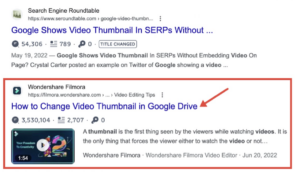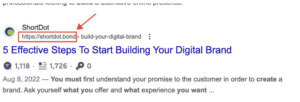
Impact of video content on SEO
In fact, according to a recent study by Cisco, video content will account for over 82% of all internet traffic by 2023. That’s a staggering number, and it means that if you’re not incorporating video into your SEO strategy, you could be missing out on a huge opportunity to drive traffic to your site.
But how do you optimize your video content for SEO? What are the best practices for video SEO that will help you rank higher in search results and get more eyeballs on your content?
In this post, we’ll dive into the impact of video content on SEO and best practices for video SEO, so you can start leveraging the power of video to improve your website’s search rankings and attract more visitors.
Why is Video Content Important?
As internet users become more visually oriented, video content has become an increasingly important factor in digital marketing and SEO. Here are some ways that video content can help improve your website’s search engine ranking:
Impact of Video Content on SEO
It’s no secret that videos hold a unique allure that mere text struggles to replicate. When visitors encounter compelling videos on your website, they’re more likely to stay awhile, forging a deeper connection. This impact goes beyond mere aesthetics—it significantly slashes bounce rates, a pivotal metric in the digital landscape.
Embracing video content isn’t just a trend; it’s a strategic move to elevate user engagement. Real data proves that videos can bring in more website visitors, improve dwell time, keep them engaged for longer, and ultimately improve the website’s search engine ranking
- From Bitable’s insights, one minute of video is similar to 120-200 words, with an average of 160 words. This packs a lot of info in a short time, which is great for getting visitors interested and keeping them on your site.
- Users typically spent 88% more time on websites that included videos, compared to those without any videos.
- A significant 87% of video marketers confirm that videos have boosted traffic to their websites.
In a world where attention spans are increasingly fleeting, video content emerges as a beacon of engagement. By adding well-made videos to your website content, you’re creating an immersive experience that effortlessly informs and resonates with visitors.
Increased Backlinks
When you create top-notch videos that people find valuable and engaging, they’re more inclined to share them. And guess what happens when your videos get shared? They also get backlinks from other websites.
Getting links from other reputable sites is like getting votes of confidence for your own site. They tell search engines that your content is worth noticing. The more quality backlinks you gather, the higher your website’s authority climbs.
By investing in valuable videos, you’re not just captivating your audience – you’re also building a stronger online reputation that search engines appreciate. It’s a win-win situation that elevates your SEO game.
Rich Snippets
You might have noticed that Google now showcases video snippets right in the search results when it determines your video is the main content of a page. These video snippets offer a visual preview of the content, giving users a sneak peek into what a video holds.

Video Content Boosts SEO
This small but impactful change has a profound implication for your SEO strategy. Video snippets not only grab more eyeballs but also have the potential to boost click-through rates.
As users are naturally drawn to visual content, having your video displayed prominently in search results can significantly increase the likelihood of users clicking on your link.
Boosting your click-through rate (CTR) demands attention to detail. Here’s an interesting tip: Consider using a new domain extension. These modern domain endings, such as .icu, .bond, or .sbs, can add a touch of freshness to your website link.
When users spot these unconventional extensions, it piques their curiosity and sets your link apart from the traditional domains. This curiosity often leads to higher click-through rates (CTR), as users are more likely to click on something that stands out and seems innovative.

Video Content Boosts SEO
Content Reusability
Video content offers more advantages than you might expect. From a single video, you can unlock its potential in various formats, broadening the possibilities far beyond its original upload.
This means that a single video can be transformed into blog posts, short-form videos for social media, infographics, and more. Imagine the reach you can achieve by catering to diverse audience preferences.
There’s a tool that can make this process even smoother—Pictory. With Pictory, you have a valuable ally that simplifies the transformation of videos into various formats. So, not only are you maximizing the impact of your video content, but you’re also making the most of your resources.
7 Best Practices for Video SEO
-
Do Keyword Research for Video Content
The significance of keyword research in video SEO cannot be overstated. Finding the right keywords can significantly boost your video’s visibility in search results. Tools such as Google Keyword Planner or KWFinder can assist in identifying relevant keywords with high search volume and low competition.
By adding these keywords to your video’s title, description, and tags, you enhance search engine comprehension of your video’s content, leading to improved rankings
-
Include Video Transcripts and Closed Captions
Including video transcripts and closed captions can help improve user experience and accessibility. Transcripts and captions can also provide search engines with more information about your video content, which can help improve your search rankings.
Search engines can crawl the text on your video page and use it to understand the content of your video. This can help your video rank higher in search results.
-
Use an Engaging Thumbnail Image
Your video’s thumbnail is the first thing users notice while scrolling through search results. A compelling thumbnail that accurately represents your content can make all the difference.
Choose a high-quality image that grabs attention and relates to your video. This encourages users to click and watch. Don’t underestimate the power of an engaging thumbnail – it’s a gateway to more views and better SEO.
-
Choose the Right Video Hosting Platform
When you’re picking a video hosting platform to put your videos on, go for one that works well with search engines. YouTube and Vimeo are good examples. These websites have special tools that can help your videos show up better when people search for things online.
It’s important to add fitting tags and put your video in the right category when you upload it. Doing this helps search engines figure out what your video is about, so they can put it higher up in the search results.
-
Schema Markup
Imagine you’re telling a search engine more about your video content in a way it understands better. This is what video schema markup does. It’s like giving the search engine a map that shows important details about your video.
When search engines understand your video better, they can put it higher in search results and more people can find it. This is done by using structured data to describe your video, like its title, description, and how long it is.

Video Content Boosts SEO
6. Don’t Duplicate Videos in Multiple Places
It’s not a good idea to upload the same video to many different places in your article. This can cause problems because search engines might think it’s duplicate content and it can hurt your search rankings.
It’s better to choose one place to embed your video and make sure it’s easy for search engines to find. You should embed the video on your website and include the video’s URL in your sitemap. This will help search engines find and show your video content to people who are searching for it.
7. Place Your Priority Video for Ranking as the Top Embedded Content on the Page

Video Content Boosts SEO
If you have more than one video on a page, it’s important to choose the most important video that you want people to see and rank high in search results. You should put this video at the top of the page where it’s easy to find.
This will help improve your search engine rankings and make it more likely that people will watch your video. You should also make sure that the video is displayed prominently on the page, so people will notice it and be more likely to click on it. This will help keep people engaged with your content and interested in what you have to say.
Conclusion
In conclusion, video content has a significant impact on SEO and it’s important to optimize your videos for search engines. By following these best practices for video SEO, you can improve your search rankings, increase user engagement, and drive more traffic to your website.
Remember to choose the right keywords, optimize your video titles and descriptions, and make sure your videos are easy to find and share. With these tips, you’ll be on your way to creating high-quality video content that not only engages your audience but also helps improve your SEO.
Author Bio:

Millie Pham
Millie Pham is an SEO content marketer at By Millie Pham. She delves into various aspects of marketing, including the power of affiliate marketing, and is passionate about the unique ways online businesses can leverage AI to grow. You can reach her at millie@bymilliepham.com.
